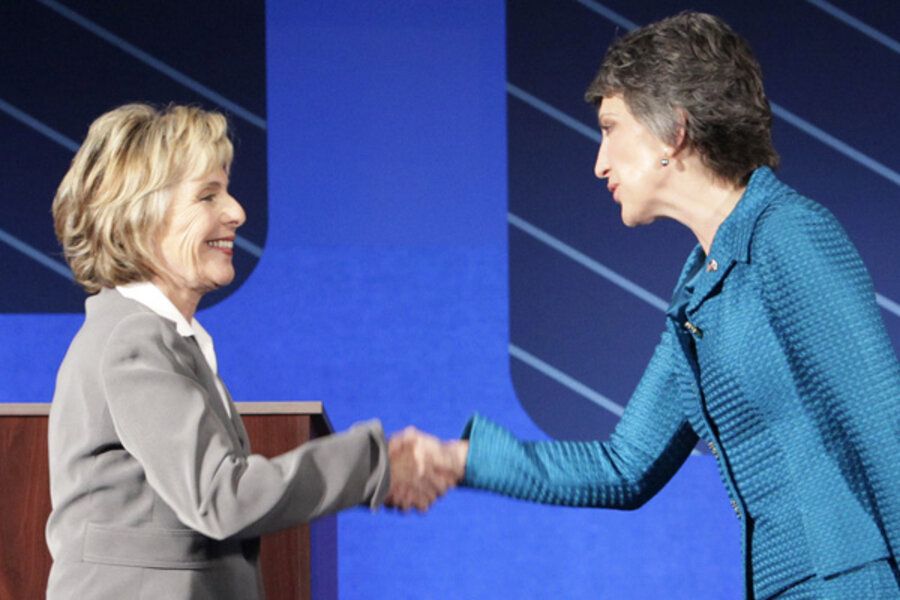Boxer-Fiorina debate: California economy is center stage
| Los Angeles
Neither candidate made any large gaffes or scored a knockout. The proceedings were fast-paced and informative, with both participants articulate and combative, feminine but in charge.
Those are the assessments of top political analysts, voters, and academics across California after the televised one-hour debate Wednesday night between Sen. Barbara Boxer (D) of California and firebrand Republican challenger Carly Fiorina, former CEO of Hewlett-Packard.
“This was a hard-hitting debate, if not a particularly spontaneous one,” says Jessica Levinson, political reform director of the Center for Governmental Studies, echoing an oft-heard analysis. “My biggest disappointment is that the event felt so scripted. At times, it seemed less like an exchange of ideas, and more like an exchange of talking points. I yearned for a moment like the one that occurred on the 'West Wing' [TV show], when both candidates agreed to throw out the rules and have a free and open dialogue about the campaign issues."
Ms. Fiorina repeatedly painted Senator Boxer as an ineffective incumbent, say Ms. Levinson and others, and Boxer drew a picture of Fiorina as a newcomer so conservative that she is out of step with Californians. The economy, which is top of mind for many Californians, took center stage. While Fiorina accused Boxer of taxing and spending the state into a fiscal mess, Boxer accused Fiorina of being a greedy CEO, firing people, shipping jobs overseas, and accepting a large severance package.
“As Boxer kept saying, there is a clear choice on issues and they kept recapping them. How you weight them and what you know about the facts will determine who you thought won,” says Barbara O’Connor, director of the Institute for Study of Politics and Media at California State University, Sacramento. She says the key issues are jobs, immigration, gay marriage, abortion, gun control, and the role and size of government.
“Assertions on both sides miscast facts. On a truth-o-meter, Boxer has an edge,” says Ms. O’Connor. “But most voters don't know it at that level. On a visceral and urgency level, it was about even. Whether people liked them more or enough to be energized about voting is unclear.”
All of the above favors the challenger, political experts say.
“Since this is Carly Fiorina’s first time running for elected office, the fact that she demonstrated her command of the issues and stood up well against a veteran US senator helps her as challenger,” says Sherry Jeffe, a political scientist at University of Southern California here.
In one parry, Boxer came out on the losing end because she looked like the Washington insider that Fiorina is trying to paint her as, says Ms. Jeffe. Fiorina said Boxer had only produced four bills with her name on them in 18 years in the Senate. Boxer countered that perhaps Fiorina didn’t really know what it took to produce a bill.
“It wasn’t Boxer’s finest moment,” says Jeffe.
Overall, voters seemed to get what they were looking for.
Neil Kraut, a Fiorina supporter who watched the debate at home, was pleasantly relieved at the exchange and wished more people could have seen it. It was carried on public radio stations and individual television stations in each of the state's 10 TV markets.
“It’s one thing for a candidate to be able to make coherent political ads with sound bites,” says Mr. Kraut. “But seeing someone speak more at length spontaneously always benefits a candidate. But this was not something like a presidential debate, where you could see it on any channel.”
Several analysts applauded the structure of the debate – questions came from ordinary voters as well as from journalists – and the moderators who kept the candidates on point.
“The moderators did a wonderful job of forcing the candidates to answer the questions,” says Levinson. “When Fiorina attempted to hedge her answers on a number of pointed questions, the moderators would accept nothing but a direct answer.”
Before the debate, Pollster.com’s survey average had Boxer in a slight lead, at 46.9 percent to 43.5 percent. Analysts say both candidates must attract the fastest-growing segment of the voter bloc: “decline to state” voters.
“They both have to get those undecided [voters] motivated and with one debate, tonight, and 30-second ads from now on … who knows?” says O’Connor at Cal State Sacramento. A second debate has not been scheduled.





